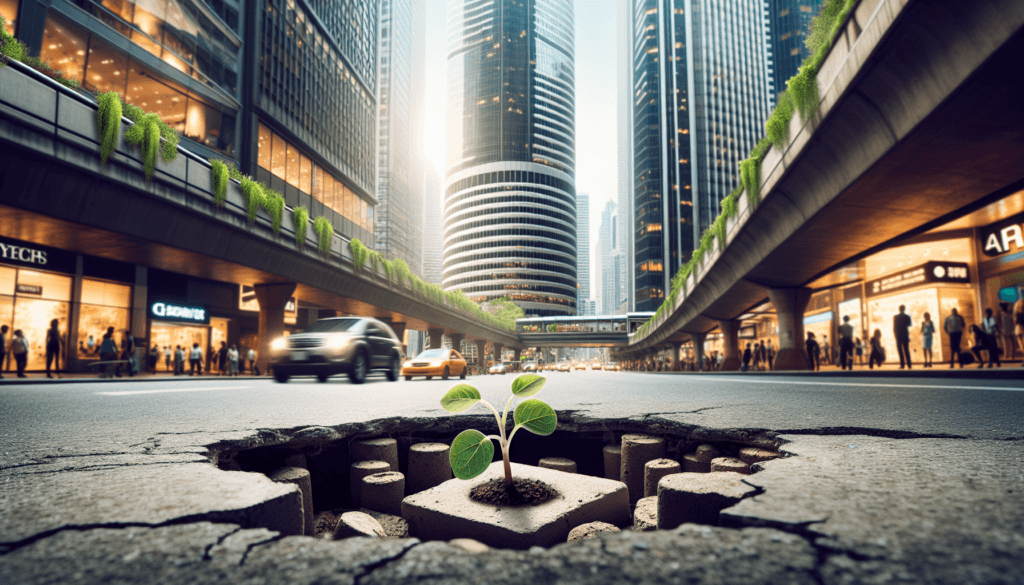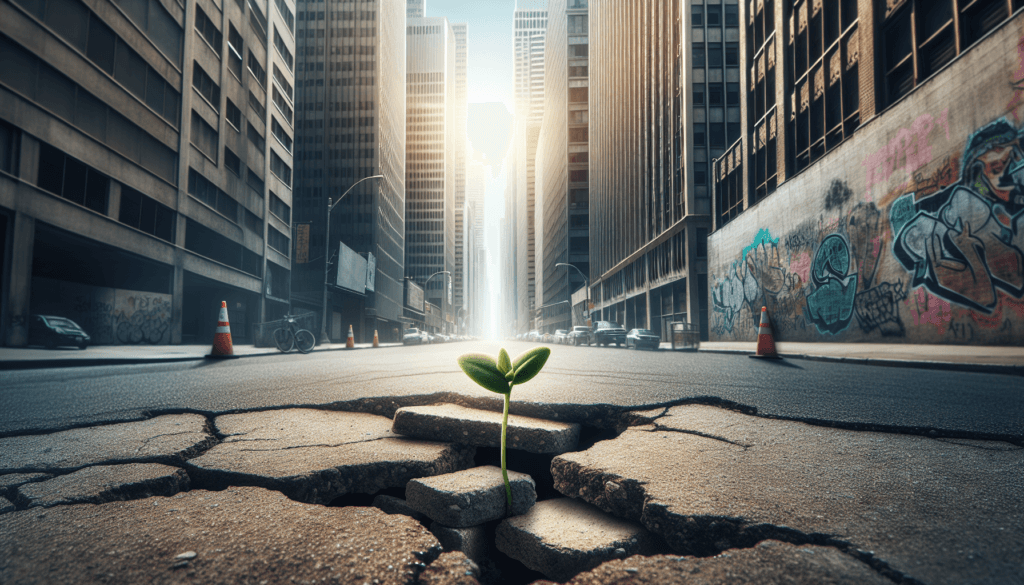In the bustling world of urban gardening, achieving successful seed starting can be a rewarding and fulfilling experience. Whether you’re a novice or a seasoned gardener, it’s crucial to understand the best practices that can help you maximize your chances of growing strong and healthy plants. From selecting the right seeds to providing the ideal growing conditions, this article will guide you through the key steps to ensure your urban garden thrives with vibrant greenery and bountiful harvests. So, grab your gardening gloves and get ready to sow the seeds of success in your very own urban garden!

Choosing the Right Seeds
When it comes to starting a successful garden, one of the most crucial factors is selecting the right seeds. Researching suitable plant varieties that thrive in your specific climate and growing conditions is the first step towards a bountiful harvest. Consider the amount of sunlight and space available in your urban garden, as these factors will determine which plants are most suitable for your environment. Take the time to explore different plant varieties and their respective requirements to ensure that you choose seeds that will flourish in your garden.
Researching Suitable Plant Varieties
Before purchasing seeds, it’s important to research suitable plant varieties for your urban garden. Each plant has different requirements in terms of sunlight, soil conditions, and temperature. Some plants, such as tomatoes and peppers, thrive in warm weather and require ample sunlight, while others, like lettuce and kale, prefer cooler temperatures and partial shade. By understanding the specific needs of each plant variety, you can choose seeds that are best suited for your particular growing environment.
Selecting High-Quality Seeds
Once you have identified the plant varieties that are suitable for your garden, it is important to choose high-quality seeds. Look for reputable seed suppliers that offer a wide selection of organic, non-GMO seeds. These seeds are more likely to produce healthy, robust plants that are resistant to pests and diseases. Avoid purchasing seeds that are past their expiration date or show signs of damage, as this may result in poor germination rates and weak seedlings. Investing in high-quality seeds will greatly increase your chances of a successful harvest.
Considering Space and Climate Constraints
Urban gardens often have limited space, so it is essential to consider the size and growth habits of the plants you choose. Some plants, like sprawling squash vines or towering sunflowers, may not be suitable for a small garden with limited vertical space. Instead, opt for compact or dwarf varieties that can be easily trellised or grown in containers. Additionally, take into account the climate constraints of your specific area. If you live in a region with hot summers or harsh winters, choose plant varieties that can withstand these extremes and still thrive.
Preparing the Soil
Before planting your seeds, it is crucial to prepare the soil to provide a healthy foundation for your plants. Testing the soil composition will help you determine its pH level and nutrient content. pH levels between 6 and 7 are generally ideal for most plants. If your soil is too acidic or alkaline, amendments may be necessary to bring it into the optimal range. Adding compost or organic matter to the soil will enrich its fertility, providing essential nutrients for your plants’ growth. Additionally, improving the drainage and aeration of the soil will prevent waterlogging and allow the roots to access oxygen, promoting healthy plant development.
Testing the Soil Composition
Testing the soil composition is an essential step in preparing your urban garden for seed starting. Soil tests can be done using at-home soil test kits or by sending samples to a professional lab. These tests measure the pH level of the soil, as well as its nutrient content. Knowing the pH level of your soil will help you determine whether amendments are necessary to bring it into the optimal range for plant growth. Furthermore, understanding the nutrient composition of your soil will allow you to make informed decisions about the types and quantities of fertilizers to use.

Amending the Soil with Compost or Organic Matter
Adding compost or organic matter to the soil is an effective way to improve its fertility and provide essential nutrients for your plants. Compost is a rich, dark material that is created by decomposing organic matter, such as kitchen scraps, yard waste, and leaves. It enhances the soil’s structure, increases its ability to hold moisture, and promotes the growth of beneficial soil microorganisms. Spread a layer of compost evenly over the garden bed and gently work it into the top few inches of soil. This will ensure that the nutrients are available to the plant roots as they grow.
Improving Drainage and Aeration
Good drainage and adequate aeration are crucial for healthy plant growth. If your soil tends to become waterlogged or compacted, it is essential to improve its drainage and aeration. To improve drainage, consider using raised beds or containers with drainage holes. This will allow excess water to escape, preventing root rot and other water-related issues. Additionally, incorporating organic matter into the soil will improve its structure, allowing for better aeration and root development. Avoid compacting the soil when planting or walking in the garden, as this can hinder the movement of air and water through the soil.
Creating an Ideal Environment
Creating an ideal environment for your plants is essential for their growth and productivity. Adequate sunlight, protection from extreme temperatures, and proper air circulation are factors to consider when setting up your urban garden.
Providing Adequate Sunlight
Most plants require at least six to eight hours of direct sunlight each day to thrive. Observe your garden throughout the day to identify areas that receive the most sunlight. Plant sun-loving crops, such as tomatoes and peppers, in these sun-drenched areas. Leafy greens and herbs, on the other hand, can tolerate partial shade and can be placed in areas with less direct sunlight. If your garden is shaded, consider utilizing techniques such as vertical gardening or reflective surfaces to maximize the amount of sunlight reaching your plants.
Protecting from Extreme Temperatures
Extreme temperatures can have a negative impact on plant growth and productivity. When temperatures soar during the summer, plants can become stressed and may require additional shade or cooling measures to prevent wilting or sunburn. Use shade cloth or erect temporary structures to provide relief from the intense heat. During colder months, protect your plants from freezing temperatures by covering them with frost blankets or bringing potted plants indoors. Understanding the temperature requirements of your plants and providing appropriate protection will ensure their survival and optimal growth.
Maintaining Proper Air Circulation
Proper air circulation is essential for preventing diseases and promoting healthy plant growth. Good air circulation helps to reduce humidity levels, minimize fungal growth, and prevent the spread of pests. Avoid overcrowding plants and allow sufficient space between them to allow for air movement. Prune plants regularly to remove dense foliage and provide better airflow. Strategic placement of fans or the use of trellises can also help improve air circulation. By maintaining proper air circulation, you can create a healthier environment for your plants and improve their overall growth and productivity.

Providing Optimal Watering
Watering is a critical aspect of seed starting in urban gardens. Different crops have different watering needs, and it is important to understand and cater to these requirements. By using the right watering techniques and avoiding overwatering or underwatering, you can provide the optimal amount of moisture for your plants.
Understanding Watering Needs of Different Crops
Plants have varying water requirements, and it is important to understand the specific needs of each crop. Some plants, such as tomatoes and cucumbers, require more frequent watering, while others, like succulents and drought-tolerant herbs, prefer drier conditions. Research the watering needs of the plants you are growing to ensure that you provide them with the right amount of moisture. Additionally, be mindful of the stage of growth your plants are in, as their water requirements may change as they develop.
Using the Right Watering Techniques
Using the right watering techniques can greatly contribute to the success of your seed starting. Water the plants at their base, close to the soil level, to ensure that the roots receive the moisture they need. Avoid overhead watering, as this can lead to the development of fungal diseases and water waste. Consider using drip irrigation systems or soaker hoses to deliver water directly to the root zone. These methods minimize evaporation and ensure that the water reaches the plants’ roots where it is most needed. Mulching around the plants with organic materials can also help retain moisture and reduce the frequency of watering.
Avoiding Overwatering and Underwatering
Overwatering and underwatering are common mistakes that gardeners make. Overwatering can lead to root rot, nutrient leaching, and the development of fungal diseases. Conversely, underwatering can cause plant wilting, poor growth, and fruit drop. To avoid overwatering, ensure that the soil is well-drained and allow the top inch or two of soil to dry out before watering again. Underwatering can be prevented by monitoring the moisture level of the soil regularly and watering when necessary. Adjust your watering practices based on the specific needs of your plants and the current weather conditions.
Implementing Effective Planting Techniques
Implementing effective planting techniques is crucial for successful seed starting in urban gardens. Proper seed sowing depths, even seed spacing, and the use of plant markers for identification are key practices to follow.
Practicing Proper Seed Sowing Depths
Each seed variety has an optimal depth at which it should be sown. Sowing seeds too deep or too shallow can result in poor germination or weak seedlings. Follow the instructions provided on the seed packets or refer to gardening resources for guidance on the appropriate seed sowing depths. As a general rule, smaller seeds should be lightly pressed into the soil surface, while larger seeds may require deeper planting. By practicing proper seed sowing depths, you will provide the optimal growing environment for your seeds and give them the best chance of germination and healthy growth.

Ensuring Even Seed Spacing
Proper seed spacing is important to allow each plant to receive adequate nutrients, water, and sunlight. Crowded plants compete for these resources, which can lead to weak growth and increased susceptibility to pests and diseases. Refer to the seed packet instructions for recommended seed spacing or refer to gardening references for appropriate spacing for specific crops. Use markers or make small indentations in the soil as guides for seed placement. By ensuring even seed spacing, you will optimize the growth and development of your plants and maximize your harvest potential.
Using Plant Markers for Identification
Using plant markers is a simple yet effective way to identify the different types of plants in your garden. Seedlings may look similar in their early stages, making it difficult to distinguish between different plant varieties. Invest in durable plant markers or create your own using recycled materials. Write the plant names or use symbols that are easily recognizable. Place the markers near each plant or seed row to help you keep track of what you have planted. This will prevent confusion and allow you to monitor the growth progress of each plant.
Implementing Pest and Disease Management
Pest and disease management is a crucial aspect of successful seed starting in urban gardens. Implementing integrated pest management strategies, encouraging beneficial insects, and regularly monitoring plants for signs of pests or diseases are effective ways to protect your plants.
Implementing Integrated Pest Management Strategies
Integrated pest management (IPM) is an environmentally friendly approach to pest control that aims to minimize the use of pesticides. IPM involves a combination of preventive measures, such as selecting pest-resistant plant varieties and practicing good garden hygiene, along with targeted interventions, such as physical barriers or the introduction of beneficial insects. By implementing IPM strategies, you can effectively manage pests while minimizing the negative impact on the environment and beneficial organisms.
Encouraging Beneficial Insects
Beneficial insects play a vital role in controlling pests in your garden. Ladybugs, lacewings, and praying mantises are natural predators that feed on common garden pests such as aphids, caterpillars, and mites. Encourage these beneficial insects to visit your garden by providing them with shelter and nectar-rich flowers. Avoid using broad-spectrum pesticides that may harm the good insects along with the pests. By attracting beneficial insects, you can maintain a natural balance in your garden and reduce the need for chemical interventions.
Regularly Monitoring Plants for Signs of Pests or Diseases
Regular monitoring of your plants is essential to detect and address pest or disease problems before they escalate. Inspect your plants regularly for any signs of pests or diseases, such as holes in leaves, discolored foliage, or wilting. Be vigilant in identifying early signs of trouble and take immediate action to prevent further damage. Remove any affected plants or plant parts, use organic sprays or insecticidal soaps for pest control, and apply appropriate fungicides for fungal diseases. By staying on top of potential issues and addressing them promptly, you can protect your plants and ensure a healthy growing environment.

Maintaining Nutrient Balance
Maintaining a proper balance of nutrients is crucial for the overall health and productivity of your plants. Understanding the nutrient requirements of different plant varieties, applying organic fertilizers, and avoiding excessive fertilizer use are key considerations.
Understanding Plant Nutrient Requirements
Different plants have specific nutrient requirements for optimal growth and development. Nitrogen, phosphorus, and potassium are the primary macronutrients needed in larger quantities, while micronutrients, such as iron, manganese, and zinc, are required in smaller amounts. Research the specific nutrient needs of the plants you are growing and monitor the soil’s nutrient levels using soil tests. This will allow you to adjust your fertilization practices to meet the individual needs of each plant variety and ensure a balanced nutrient supply.
Applying Organic Fertilizers
Organic fertilizers are derived from natural sources and provide a slow-release, sustainable source of nutrients for your plants. Composted manure, fish emulsion, and worm castings are examples of organic fertilizers that enrich the soil and promote healthy plant growth. Apply organic fertilizers according to the recommended rates and timings specific to each plant variety. Avoid excessive fertilization, as this can lead to nutrient imbalances, excess plant growth, and reduced fruit or flower production.
Avoiding Excessive Fertilizer Use
While fertilizers are essential for plant growth, excessive use can have detrimental effects on your plants and the environment. Over-fertilization can result in nutrient imbalances, nutrient leaching into water sources, and the accumulation of excess salts in the soil. Follow the recommended rates and timings specific to each plant variety, and monitor your plants’ response to fertilization. Regular soil testing can help determine the nutrient status of your soil and guide your fertilization practices. By avoiding excessive fertilizer use, you can maintain a healthy nutrient balance in your garden and reduce the risk of environmental contamination.
Practicing Proper Thinning and Transplanting
Thinning seedlings to provide adequate growing space and transplanting seedlings at the right stage are crucial steps in ensuring the healthy development of your plants.
Thinning Seedlings to Provide Adequate Growing Space
Seedlings that are overcrowded can compete for resources and fail to reach their full potential. Thinning seedlings is the process of removing excess seedlings to create enough space for the remaining plants to grow. When thinning, choose the strongest and healthiest seedlings to keep and remove the weaker ones. Follow the spacing recommendations on the seed packet or gardening resources as a guide. Thinning encourages vigorous growth, prevents plant diseases, and improves air circulation around the plants.
Transplanting Seedlings at the Right Stage
Transplanting seedlings at the right stage is crucial for their successful establishment in the garden. Seedlings should be transplanted when they have developed a strong root system and have at least two sets of true leaves. Be gentle when removing the seedlings from their containers or seed trays to minimize root damage. Dig a hole in the prepared soil that is deep enough to cover the seedling’s root system, and carefully place the seedling in the hole. Firm the soil around the base of the seedling to provide support. Water the seedlings after transplanting to help them adjust to their new environment.
Taking Care to Minimize Transplant Shock
Transplant shock can occur when seedlings are moved from their original containers or environments to a new location. To minimize transplant shock, handle the seedlings carefully and minimize root disturbance. Transplant on a cloudy day or in the evening to reduce stress from direct sunlight. Water the seedlings before transplanting and water immediately after transplanting to help them rehydrate. Provide shade or a protective cover for a few days to help the seedlings acclimate to their new surroundings. By taking these precautions, you can reduce transplant shock and ensure that your seedlings continue to grow and thrive.
Monitoring and Adjusting Growing Conditions
Regularly observing plant growth and health, adjusting watering, lighting, and nutrient levels, and addressing problems in a timely manner are all vital for the success of your urban garden.
Regularly Observing Plant Growth and Health
Regular observation of your plants’ growth and health is essential for identifying any issues or abnormalities. Take the time to examine your plants closely, noting any changes in color, size, or texture. Look for signs of insect damage, disease, or nutrient deficiencies. Regular inspection allows you to detect early signs of trouble and take appropriate action to prevent further damage. By being attentive to your plants’ needs, you can intervene proactively and ensure their continued health and productivity.
Adjusting Watering, Lighting, and Nutrient Levels
As your plants grow and develop, their needs may change. It is important to regularly assess and adjust their watering, lighting, and nutrient levels accordingly. Monitor the moisture level of the soil and adjust your watering practices to ensure that your plants are receiving the optimal amount of water. Evaluate the amount and quality of light your plants are receiving and make adjustments as necessary, such as moving pots or adjusting artificial lighting. Regularly test the nutrient levels of your soil and adjust your fertilization practices to meet your plants’ changing needs. By providing the right conditions, you can support healthy growth and maximize your garden’s productivity.
Identifying and Addressing Problems in a Timely Manner
Timely identification and prompt resolution of problems are crucial for maintaining a healthy garden. Act quickly if you notice signs of pests, diseases, or nutrient deficiencies. Use organic pest control methods, such as handpicking pests or applying insecticidal soaps, to address pest infestations. Consult gardening references or seek advice from local experts to accurately diagnose and treat plant diseases. Adjust your fertilization practices or apply foliar sprays to correct nutrient deficiencies. By promptly addressing problems, you can prevent further damage and ensure the overall health and vitality of your plants.
Seeking Knowledge and Learning from Experience
Gardening is a continuous learning process, and seeking knowledge and learning from experience are invaluable in growing a successful urban garden.
Joining Gardening Communities or Groups
Joining gardening communities or groups provides opportunities to connect with fellow gardeners, exchange ideas, and learn from their experiences. Online forums, social media groups, and local gardening clubs provide platforms for sharing tips, asking questions, and receiving advice. Engaging with experienced gardeners can broaden your knowledge, inspire new ideas, and help troubleshoot any challenges you may encounter. By joining a gardening community or group, you can tap into a wealth of collective wisdom and accelerate your gardening journey.
Attending Workshops or Classes
Attending workshops or classes offered by local gardening centers, agriculture extension offices, or botanical gardens is an excellent way to expand your gardening skills and knowledge. These educational opportunities cover a wide range of topics, from seed starting techniques to pest management strategies. Learn from expert instructors, participate in hands-on activities, and engage with like-minded gardeners. Workshops and classes provide valuable insights, practical tips, and a supportive learning environment.
Experimenting with Different Techniques and Varieties
The best way to learn and grow as a gardener is through hands-on experimentation. Don’t be afraid to try new techniques, explore different plant varieties, and experiment in your garden. Test different planting methods, modify growing conditions, or try companion planting. Keep a gardening journal to record your observations, successes, and failures. By experimenting and learning from your experiences, you will gain valuable insights into what works best in your specific urban garden.
In conclusion, successful seed starting in urban gardens requires careful consideration of various factors. By choosing the right seeds, preparing the soil, creating an ideal environment, providing optimal watering, implementing effective planting techniques, managing pests and diseases, maintaining nutrient balance, practicing proper thinning and transplanting, monitoring and adjusting growing conditions, and seeking knowledge and learning from experience, you can cultivate a thriving and productive urban garden that yields a bountiful harvest. Happy gardening!


